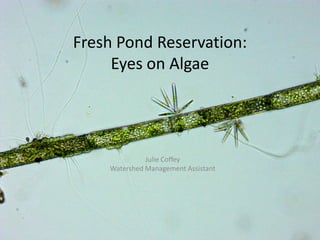Algae Presentation
- 1. Fresh Pond Reservation: Eyes on Algae Julie Coffey Watershed Management Assistant
- 2. Tonightâs objectives: âĒ Understand the importance of algae âĒ Learn how the Cambridge Water Department is monitoring algae âĒ Discover some common genera of algae and learn identifying features
- 3. What are algae? Algae is a BROAD term, from diatoms to kelp: Some resemble plantsâĶ Others bacteriaâĶ Still others protistsâĶ
- 4. Algae, A Brief History: 3.5 Billion Years Ago
- 5. A group of aquatic, photosynthetic, eukaryotic organisms ranging from unicellular to multicellular and generally possessing chlorophyll but lacking true roots, stems, or leaves. Algae, Defined:
- 6. Classification: âĒ Cell wall composition âĒ Motile or non-motile âĒ Colonial or individual âĒ Pigmentation
- 7. Plankton âPlanktonâ from the Greek word planktos Haloplankton-always present as plankton Meroplankton-have resting stages in the sediment
- 8. Habitat âĒ Freshwater ecosystems âĒ Saltwater ecosystems âĒ Soils âĒ Hot springs âĒ Moss/Lichens âĒ Turtle carapaces, fur of the 3-toed sloth
- 11. âĒSize as defense âĒResource sharing âĒCell differentiation: reproduction âĒImproved mobility/reduced sinking Colonial Algae:
- 12. Importance of Algae: Oxygen Oxygen Chlorophyll
- 13. Importance of Algae: Fisheries In 2011: $200 billion generated $433 million in Massachusetts 1.7 million jobs Phytoplankton as primary producers!
- 16. Importance of Algae: Fossil Fuels Oceanic oil deposits Biofuel potential
- 17. Diatoms âĒ Golden-brown algae âĒ Cell walls made up of Silica â Strong influence on function âĒ 25% Global Net Primary Productivity
- 18. Diatomite Silica deposits from diatoms used in: âĒ Filtration for beer/wine, pools âĒ Industrial absorbents âĒ Grit in toothpaste âĒ Road paint
- 19. Blue-green Algae (Cyanobacteria) Photosynthesizing bacteria âĒ Pioneered photosynthesis, sexual reproduction, urea cycles âĒ Vertical regulation: gas vacuoles and metabolism (stratification)
- 20. Why We Care About Algae: ï§ Water Quality ï§ Indication of watershed health ï§ Community baseline ( and theyâre really fun to look at...)
- 21. Preventing Algal Blooms Causes: Nutrient loading (N,P) Eutrophication Temperature (growth rate) Effects: Shading/competition Oxygen depletion Presence of Cyanotoxins
- 22. CWD Algae Monitoring Program âĒ Volunteer monitoring in Blackâs Nook and Little Fresh Pond since 2003 âĒ Chl-a samples from reservoirs 12/18/2004, LFP Phytoplankton Zooplankton Asterionella Copepods Pediastrum Cladocerans Dinobryon Ostracods Staurastrum
- 23. CWD Algae Program Goals Weekly reservoir monitoring âIdentify and quantify populations Continue reservation monitoring âAnalyze historical data for trends
- 24. Algae of Little Fresh Pond Pediastrum, LFP, 1/12/15 Synura, LFP, 1/12/15 Staurastrum, 12/22/2014
- 25. Staurastrum, LFP 1/12/15 Crucigenia, LFP 1/12/15 Algae of Little Fresh Pond
- 27. Blackâs Nook 11/24/2014 Ceratium: golden algae, dinoflagellate, protozoan Closterium, green algae Centronella: Diatom Dinobryon: golden- algae, diatom
- 29. Blackâs Nook Pediastrum Species Note: Pediastrum are most often found in quiet waters
- 30. Now on to the fun partâĶ
- 31. Additional Resources Glossary of algal terms: http://westerndiatoms.colorado.edu/glossary Algae pictures for ID: http://www.keweenawalgae.mtu.edu/ Detailed species descriptions: http://algaebase.org/search/genus/ Credits: Kelp-http://www.geog.ucsb.edu/events/department-news/983/paper-by-libe-washburn-selected-as-an-agu-research-spotlight/ Sloth-https://animalartsdesignstudio.wordpress.com/2013/09/19/biomimicry-and-the-sloth/ Diatomite-http://pubs.usgs.gov/fs/2006/3044/fs-2006-3044.pdf, http://elkorose.schopine.com/vivian.html Black duck-http://bna.birds.cornell.edu/bna/species/481/galleries/photos/RNB_American-Black-Duck-0007 Coyote-http://featheredphotography.com/blog/wp-content/uploads/2012/12/coyote-8829-ron-dudley.jpg O2 production-https://scripps.ucsd.edu/biblio/algae-worlds-most-important-plants-introduction Tree of life http://www.encognitive.com/node/10795 Cycle-Microbial control of the dark end of the biological pump, Herndl, G; Reinthaler,T Herring: "Clupea harengus Gervais.flipped" by Gervais et Boulart, 1877 - flipped version of File:Clupea harengus Gervais.jpg - Les poissons Gervais, H.. Licensed under Public Domain via Wikimedia Commons - http://commons.wikimedia.org/wiki/File:Clupea_harengus_Gervais.flipped.jpg#mediaviewer/File:Clupea_harengus_Gervais.flipped.jpg Bloom-http://www.clf.org/blog/tag/nutrient-pollution/ Algae age-http://www.ucmp.berkeley.edu/bacteria/cyanofr.html Algal maps:http://askabiologist.asu.edu/explore/plankton, world ocean atlas via wikipedia






























